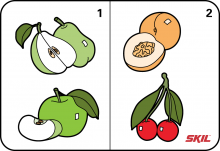-
When should you prune your fruit tree?
Pome fruit trees (1) include apple trees and pear trees. You should prune these trees between early January and early March. If you start pruning any earlier the tree will be susceptible to diseases that can damage the trunk and branches. Pome fruit trees should always be pruned when the weather is dry. Pruning should never be done during periods of severe frost.
Stone fruit trees (2) include cherry trees, plum trees, peach trees and apricot trees. It’s better not to prune stone fruit trees in the winter, as they can be infected by mildew. Prune stone fruit trees after the flowering season in April/May or after picking in August/September. -
What tool do you need to prune your fruit trees?
Generally, secateurs, a pruning saw and loppers are the best tools for pruning your fruit tree. Use secateurs for the thinner branches, a pruning saw for the thicker branches and loppers for the hard-to-reach branches. -
How should you prune your fruit trees?
Prune back old branches and branches that produce little fruit to around 10cm (4 inches) from the trunk. If a branch splits in two, remove one of the branches. That will create an optimal flow of sap to the fruit. Branches growing downwards or inwards can be removed. Cut branches at the trunk to ensure no new shoots are formed.



